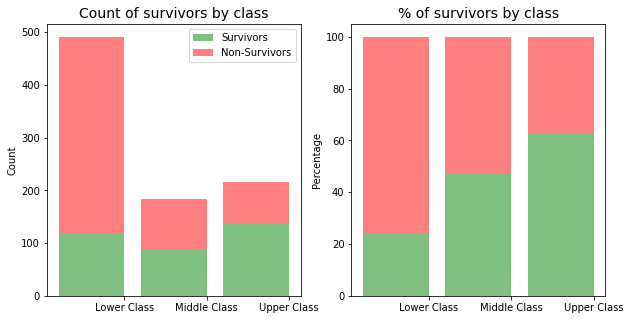#importing of required modules
import numpy as np
import pandas as pd
import matplotlib.pyplot as plt
import seaborn as sns
import ipy_table as tbl
from numbers import Number
from scipy import stats
#allow plots and visualisations to be displayed in the report
%matplotlib inline1. Introduction
For this project we were asked to select a dataset and using the data answer a question of our choosing. I selected the Titanic Data Set which looks at the characteristics of a sample of the passengers on the Titanic, including whether they survived or not, gender, age, siblings / spouses, parents and children, fare (cost of ticket), embarkation port.
After looking at the contents of the dataset, I thought it would be interesting to look at the following questions:
- Which gender had a better chance of survival?
- Which social class had a better chance of survival?
- Which age group had a better chance of survival?
Dataset Information/ Data Dictionary/Variable Notes
The sinking of the RMS Titanic is one of the most infamous shipwrecks in history. On April 15, 1912, during her maiden voyage, the Titanic sank after colliding with an iceberg, killing 1502 out of 2224 passengers and crew. This sensational tragedy shocked the international community and led to better safety regulations for ships.
One of the reasons that the shipwreck led to such loss of life was that there were not enough lifeboats for the passengers and crew. Although there was some element of luck involved in surviving the sinking, some groups of people were more likely to survive than others, such as women, children, and the upper-class.
Titanic Data - Contains demographics and passenger information from 891 of the 2224 passengers and crew on board the Titanic.
| Variable | Definition | Key |
|---|---|---|
| Survived | Survival | 0 = No, 1 = Yes |
| Pclass | Ticket class | 1 = 1st, 2 = 2nd, 3 = 3rd |
| Sex | Sex | |
| Age | Age in years | |
| Sibsp | Number of siblings / spouses aboard the Titanic | |
| Parch | Number of parents / children aboard the Titanic | |
| Ticket | Ticket number | |
| Fare | Passenger fare | |
| Cabin | Cabin number | |
| Embarked | Port of Embarkation | C = Cherbourg, Q = Queenstown,S = Southampton |
Pclass: A proxy for socio-economic status (SES) 1st = Upper 2nd = Middle 3rd = Lower
Age: Age is fractional if less than 1. If the age is estimated, is it in the form of xx.5
Sibsp: The dataset defines family relations in this way…
Sibling = brother, sister, stepbrother, stepsister
Spouse = husband, wife (mistresses and fiancés were ignored)
Parch: The dataset defines family relations in this way…
Parent = mother, father
Child = daughter, son, stepdaughter, stepson
Some children travelled only with a nanny, therefore parch=0 for them.
2. Setting up report
In order to analyse and report on the data, I have choosen to use ipython notebook, along with the numpy, pandas, matplotlib.pyplot and seaborn python modules. In order to use these modules they needed to be imported into the notebook first as per below.
def as_percent(val, precision='0.2'):
"""Convert number to percentage string."""
if isinstance(val, Number):
return "{{:{}%}}".format(precision).format(val)
else:
raise TypeError("Numeric type required")
def calculate_percentage(val, total, format_percent = False):
"""Calculates the percentage of a value over a total"""
percent = np.divide(val, total, dtype=float)
if format_percent:
percent = as_percent(percent)
return percent3. Read CSV into dataframe
# Read csv into Pandas Dataframe and store in dataset variable
titanic_df = pd.read_csv('titanic_data.csv')4. Data Wrangling / Cleaning
Before working with the data I needed to look at what needed to be cleaned up, i.e. find missing data, remove data that will not assist with the analysis.
4.1 Investigating Dataset and finding missing / incomplete data
# print out information about the data
titanic_df.info()<class 'pandas.core.frame.DataFrame'>
RangeIndex: 891 entries, 0 to 890
Data columns (total 12 columns):
# Column Non-Null Count Dtype
--- ------ -------------- -----
0 PassengerId 891 non-null int64
1 Survived 891 non-null int64
2 Pclass 891 non-null int64
3 Name 891 non-null object
4 Sex 891 non-null object
5 Age 714 non-null float64
6 SibSp 891 non-null int64
7 Parch 891 non-null int64
8 Ticket 891 non-null object
9 Fare 891 non-null float64
10 Cabin 204 non-null object
11 Embarked 889 non-null object
dtypes: float64(2), int64(5), object(5)
memory usage: 83.7+ KBAfter printing out the dataset information above, we can see that the Age, Cabin and Embarked columns are missing entries. As the Cabin column is not relevant to the analysis of the data I will be removing that column however I will need to find a way update populate the missing ages and embarked port.
4.2 Missing Ages
In order to populate the missing ages I will use the mean age based on the Sex and Pclass
missing_ages = titanic_df[titanic_df['Age'].isnull()]
# determine mean age based on Sex and Pclass
mean_ages = titanic_df.groupby(['Sex','Pclass'])['Age'].mean()
def remove_na_ages(row):
'''
function to check if the age is null and replace wth the mean from
the mean ages dataframe
'''
if pd.isnull(row['Age']):
return mean_ages[row['Sex'],row['Pclass']]
else:
return row['Age']
titanic_df['Age'] = titanic_df.apply(remove_na_ages, axis=1)4.3 Missing embarkation ports
In order to populate the missing embarked ports I need to first determine if the people with the missing information may have been travelling with others.
missing_ports = titanic_df[titanic_df['Embarked'].isnull()]
missing_ports| PassengerId | Survived | Pclass | Name | Sex | Age | SibSp | Parch | Ticket | Fare | Cabin | Embarked | |
|---|---|---|---|---|---|---|---|---|---|---|---|---|
| 61 | 62 | 1 | 1 | Icard, Miss. Amelie | female | 38.0 | 0 | 0 | 113572 | 80.0 | B28 | NaN |
| 829 | 830 | 1 | 1 | Stone, Mrs. George Nelson (Martha Evelyn) | female | 62.0 | 0 | 0 | 113572 | 80.0 | B28 | NaN |
# search by ticket number and cabin
titanic_df[(titanic_df['Embarked'].notnull()) & ((titanic_df['Ticket'] == '113572') | (titanic_df['Cabin'] == 'B28'))]| PassengerId | Survived | Pclass | Name | Sex | Age | SibSp | Parch | Ticket | Fare | Cabin | Embarked |
|---|
Since searching for similar records did not return any results and it appears that both were travelling in the same cabin and with the same ticket number and the bulk of passengers were travelling from Southhampton, I have choosen to use Southhampton as the missing value.
titanic_df['Embarked'].fillna('S',inplace=True)4.4 Remove un-wanted columns
Since the Cabin, Name and Ticket numbers are not required in this analysis I will remove them to improve the speed of processing the dataframe.
# dropping columns Cabin, Name and Ticket
titanic_df = titanic_df.drop(['Cabin','Name','Ticket'], axis=1)
titanic_df.info()<class 'pandas.core.frame.DataFrame'>
RangeIndex: 891 entries, 0 to 890
Data columns (total 9 columns):
# Column Non-Null Count Dtype
--- ------ -------------- -----
0 PassengerId 891 non-null int64
1 Survived 891 non-null int64
2 Pclass 891 non-null int64
3 Sex 891 non-null object
4 Age 891 non-null float64
5 SibSp 891 non-null int64
6 Parch 891 non-null int64
7 Fare 891 non-null float64
8 Embarked 891 non-null object
dtypes: float64(2), int64(5), object(2)
memory usage: 62.8+ KB4.5 Mapping data (values to descriptions)
In order to intrepret the data easier the following fields need to be modified:
Survived - changed to boolean (1 = True, 0 = False) Pclass - changed to Socio-Economic status (1st - Upper Class, 2nd - Middle Class, 3rd - Lower Class) Embarked - changed to name of embarkation port (C = Cherbourg; Q = Queenstown; S = Southampton) I will also add a Family Size column so that I can compare the size of families with the number of survivors.
def map_data(df):
'''
Function which takes the original dataframe and returns a
clean / updated dataframe
'''
# survived map
survived_map = {0: False, 1: True}
df['Survived'] = df['Survived'].map(survived_map)
# PClass map
pclass_map = {1: 'Upper Class', 2: 'Middle Class', 3: 'Lower Class'}
df['Pclass'] = df['Pclass'].map(pclass_map)
# Embarkation port map
port_map = {'S': 'Southampton', 'C': 'Cherbourg','Q':'Queenstown'}
df['Embarked'] = df['Embarked'].map(port_map)
# add new column (FamilySize) to dataframe - sum of SibSp and Parch
df['FamilySize'] = df['SibSp'] + df['Parch']
return df
titanic_df = map_data(titanic_df)
titanic_df.head(3)| PassengerId | Survived | Pclass | Sex | Age | SibSp | Parch | Fare | Embarked | FamilySize | |
|---|---|---|---|---|---|---|---|---|---|---|
| 0 | 1 | False | Lower Class | male | 22.0 | 1 | 0 | 7.2500 | Southampton | 1 |
| 1 | 2 | True | Upper Class | female | 38.0 | 1 | 0 | 71.2833 | Cherbourg | 1 |
| 2 | 3 | True | Lower Class | female | 26.0 | 0 | 0 | 7.9250 | Southampton | 0 |
4.6 Grouping / Binning Ages
To make the ages easier to analyse I thought it would be a good idea to group / bin the ages. This way we can compare groups of ages instead of individual ages.
age_labels = ['0-9', '10-19', '20-29', '30-39', '40-49', '50-59', '60-69', '70-79']
titanic_df['age_group'] = pd.cut(titanic_df.Age, range(0, 81, 10), right=False, labels=age_labels)
titanic_df.head(3)| PassengerId | Survived | Pclass | Sex | Age | SibSp | Parch | Fare | Embarked | FamilySize | age_group | |
|---|---|---|---|---|---|---|---|---|---|---|---|
| 0 | 1 | False | Lower Class | male | 22.0 | 1 | 0 | 7.2500 | Southampton | 1 | 20-29 |
| 1 | 2 | True | Upper Class | female | 38.0 | 1 | 0 | 71.2833 | Cherbourg | 1 | 30-39 |
| 2 | 3 | True | Lower Class | female | 26.0 | 0 | 0 | 7.9250 | Southampton | 0 | 20-29 |
5. Analysis of data
5.1 Number of Survivors
survivors_data = titanic_df[titanic_df.Survived==True]
non_survivors_data = titanic_df[titanic_df.Survived==False]5.2 Which gender had a better chance of survival?
In order to answer this question we need to look at how many males and females were on board and which gender had the highest survival rate.
Count of Survivors by Gender
table = pd.crosstab(titanic_df['Survived'],titanic_df['Sex'])
print(table)Sex female male
Survived
False 81 468
True 233 109Proportion of survivors by Gender
print(titanic_df.groupby('Sex').Survived.mean())Sex
female 0.742038
male 0.188908
Name: Survived, dtype: float64# calculate values for each survival status
survivors_gender = survivors_data.groupby(['Sex']).size().values
non_survivors_gender = non_survivors_data.groupby(['Sex']).size().values
# calculate totals for percentates
totals = survivors_gender + non_survivors_gender
# use calculate_percentage_function to calculate percentage of the total
data1_percentages = calculate_percentage(survivors_gender, totals)*100
data2_percentages = calculate_percentage(non_survivors_gender, totals)*100
gender_categories = ['Female', 'Male']
f, (ax1, ax2) = plt.subplots(1, 2, figsize=(10,5))
# plot chart for count of survivors by class
ax1.bar(range(len(survivors_gender)), survivors_gender, label='Survivors', alpha=0.5, color='g')
ax1.bar(range(len(non_survivors_gender)), non_survivors_gender, bottom=survivors_gender, label='Non-Survivors', alpha=0.5, color='r')
plt.sca(ax1)
plt.xticks([0.4, 1.4], gender_categories )
ax1.set_ylabel("Count")
ax1.set_xlabel("")
ax1.set_title("Count of survivors by gender",fontsize=14)
plt.legend(loc='upper left')
# plot chart for percentage of survivors by class
ax2.bar(range(len(data1_percentages)), data1_percentages, alpha=0.5, color='g')
ax2.bar(range(len(data2_percentages)), data2_percentages, bottom=data1_percentages, alpha=0.5, color='r')
plt.sca(ax2)
plt.xticks([0.4, 1.4], gender_categories)
ax2.set_ylabel("Percentage")
ax2.set_xlabel("")
ax2.set_title("% of survivors by gender",fontsize=14)Text(0.5, 1.0, '% of survivors by gender')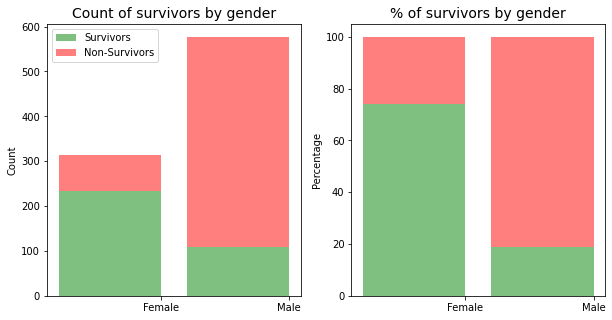
The plots and proportions above show that there were a significant more males on board the Titanic compared to the number of females. Whilst the second plot (% of survivors by gender) shows that Females had a higher proportion (74.2%) of survivors compared to the proportion of males (18.9%). This shows that females had a greater rate of survival.
5.4 Which age group had a better chance of survival?
Distribution of Age Groups
titanic_df.groupby(['age_group']).size().plot(kind='bar',stacked=True)
plt.title("Distribution of Age Groups",fontsize=14)
plt.ylabel('Count')
plt.xlabel('Age Group');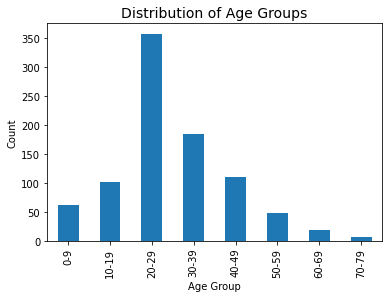
From the plot above we can see that the majority of passengers were aged between 20-29
Proportion of survivors by age group
# CODE HEREage_group
0-9 0.612903
10-19 0.401961
20-29 0.315642
30-39 0.454054
40-49 0.354545
50-59 0.416667
60-69 0.315789
70-79 0.000000
Name: Survived, dtype: float64# CODE HEREText(0.5, 1.0, '% of survivors by age group')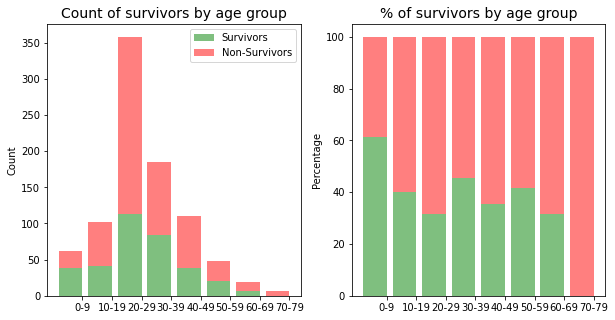
When looking at proportions and percentages of survivors per age group, initially I was suprised by the results, until I thought that this analysis shoudl take into consideration the gender / sex of the passengers as well.
print(titanic_df.groupby(['Sex','age_group']).Survived.mean())Sex age_group
female 0-9 0.633333
10-19 0.755556
20-29 0.681034
30-39 0.855072
40-49 0.687500
50-59 0.888889
60-69 1.000000
70-79 NaN
male 0-9 0.593750
10-19 0.122807
20-29 0.140496
30-39 0.215517
40-49 0.217949
50-59 0.133333
60-69 0.133333
70-79 0.000000
Name: Survived, dtype: float64male_data = titanic_df[titanic_df.Sex == "male"].groupby('age_group').Survived.mean().values
female_data = titanic_df[titanic_df.Sex == "female"].groupby('age_group').Survived.mean().values
ax = plt.subplot()
male_plt_position = np.array(range(len(age_labels)))
female_plt_position = np.array(range(len(age_labels)))+0.4
ax.bar(male_plt_position, male_data,width=0.4,label='Male',color='b')
ax.bar(female_plt_position, female_data,width=0.4,label='Female',color='r')
plt.xticks(tick_spacing, age_labels)
ax.set_ylabel("Proportion")
ax.set_xlabel("Age Group")
ax.set_title("Proportion of survivors by age group / Gender",fontsize=14)
plt.legend(loc='best')
plt.show()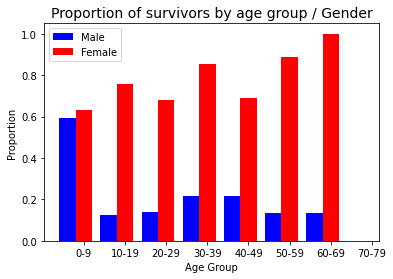
After relooking at the proportion of survivors by age group and gender, the data supports notion of women and children to be given preferential treatment over men. The plot “Proportion of survivors by age group / gender”, shows that children (0-9 years old, male and female) and women (all ages) had a much higher proportion of survivors. This supports the notion of the seats in the lifeboats been given to Women and Children first.
6. Conclusion
6.1 Limitations of dataset
The are a number of limitations with the Titanic Dataset, which are caused by:
- missing data
- only been a sample of the data
The missing data and size of the sample could skew the results for example the missing ages.
print(missing_ages.groupby('Sex').size())Sex
female 53
male 124
dtype: int64The above shows that there were 53 ages missing for females and 124 ages missing for males. I had a choice with how to handle the missing ages each with their pros and cons.
delete the rows with the missing ages - this would limit the accuracy of the analysis of the gender and class, however the accuracy of the analysis of the Age factor would be more accurate generate ages based on the mean of ages - this could skew the results of the age analysis. In section 4.2, I choose this option, however I based the ages on the average for the Gender and Class. The size of the sample data could also impact the results as we don’t know if this is a random sample or if the selection of the data is biased or unbiased.
6.2 Other variables
As with most datasets the more information we have the better it can be analysed. I believe that we could add the following variables:
- passenger or crew - the current dataset doesn’t distingush between passenger or crew, however from history we know that a mixture of both survived.
- life boat number - the reason why there were so many fatalities on board the Titanic was due to there not been enough lifeboats. I believe that if we knew the lifeboat number and the capacity of a lifeboat we could determine if it was possible for more people to survive

